“In Israel, we like to invite people, and we like to cook for them, it is part of our DNA, we are pleased when people have fun.”
Paprika is a Middle Eastern street food restaurant near I. P. Pavlova. Small, cozy bistro with smiling staff. You have to count on the fact that there will be a bit of a fight over the lunch and if you do not go for a takeaway meal, you will not go wrong with a reservation.
Vegetarians and vegans, as well as meat-eaters, are welcome. Fixed menus are typical Israeli dishes such as hummus, falafel, sabich or fried eggplant, shawarma, gyros, kebab or shakshuka, a dish made by eggs cooked in tomato-paprika sauce with onions. There is also homemade pita bread. Everything is fresh and made from the best ingredients, many of which are imported directly from Israel.
Moreover, you can also buy some goods such as biscuits, tahini, spices, bread, etc. The menu is at first look a bit confusing, and you may not understand all the ingredients, so we recommend you to get advice from the staff, which is incredibly friendly and helpful. Meals can also be prepared in the form of catering. In the bistro, you can often find the owners themselves, Yadin and Gala, behind the bar or the kitchen. These smiling and friendly co-owners will introduce you to the secrets of Israeli cuisine. They both know Czech, but we recommend speaking to them in English for a better conversation. Paprika has been opened since July 2017, and it does not lack in customers. Yadin and Gal have been looking for larger spaces for some time.
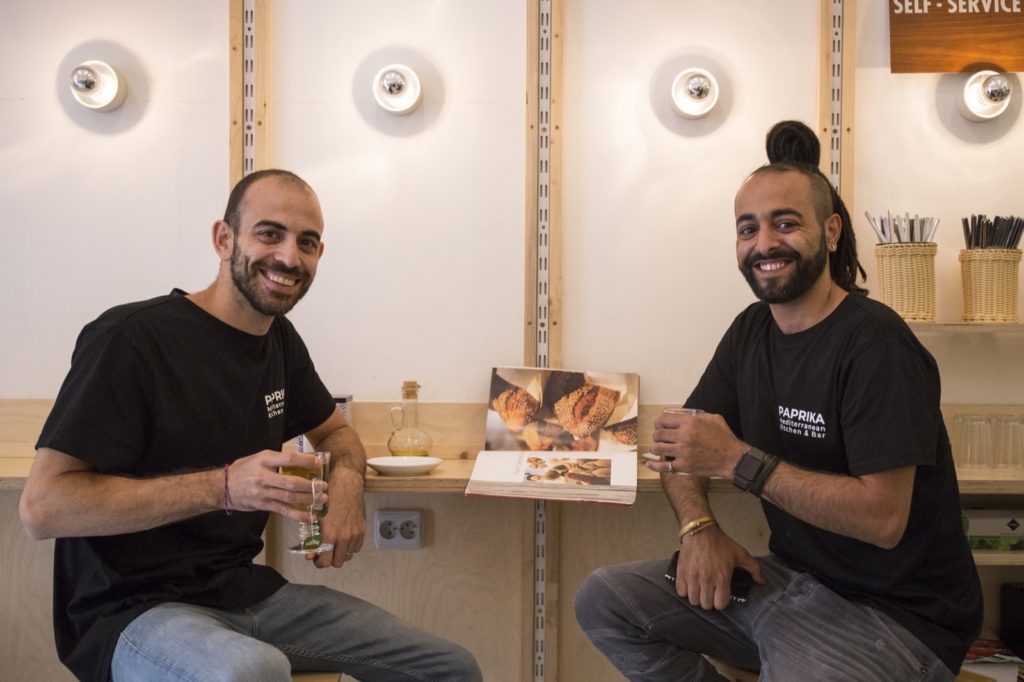
Photo © Alžběta Diringerová
What is the story of Paprika?
Yadin: “Gal and I met about a year ago. We have friends in common and found out that we lacked Israeli food in Prague, so we decided to open our bistro”.
Have you had any experience in running a restaurant in Israel?
Yadin: “No, food is our hobby. We cook at home.”
Gal: “In Israel, we like to invite people to visit, we like to cook for them, it’s part of our DNA, we are pleased when people enjoy themselves.”
Yadin: “I’ve lived in Europe for many years, but I always cook at home. I do hummus, falafel and other things from back home. But sometimes one wants to go out and share food with friends.
Gal: “We enjoy having people from different countries and cultures, meeting and sharing food at the same table. See the salt crystals? They are not just for decoration. It’s because there is always good energy. Seventy percentage of our customers are Czech, and the rest are foreigners, students, and tourists. The Paprika team is also international (Nepal, India, Ukraine, Czech Republic and of course Israel)”.
How do Czechs react to food, and how do you perceive the majority of the society?
Yadin: “We love the Czech Republic. I think the Czechs are very gentle and friendly people, not at all aggressive. Not everybody speaks English, but if you speak at least a little Czech, they will very much appreciate it and be helpful. People like to try new things here. In addition to the permanent menu, we also prepare small tastings and then observe the guests’ reactions. Thanks to this, we can progress”.
Gal: “The Czechs are liberal people. If you behave decently and do not bother anyone, you can live a pleasant life here. My neighbors are very nice people, old and young, all very kind”.
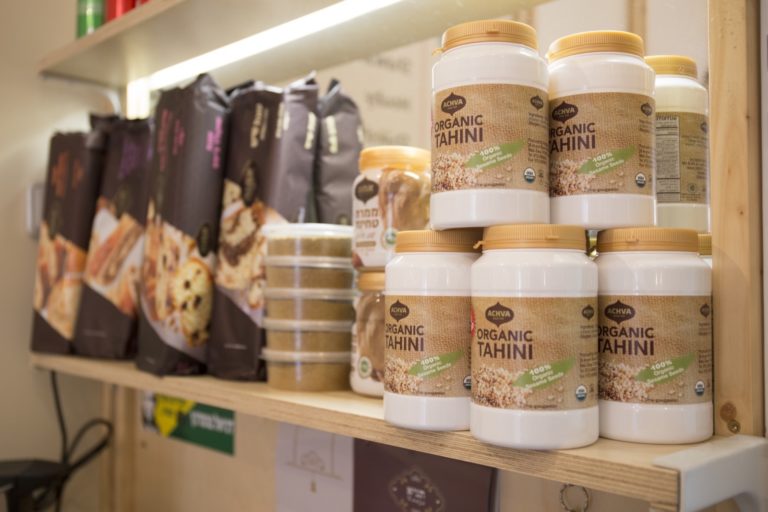
Photo © Alžběta Diringerová
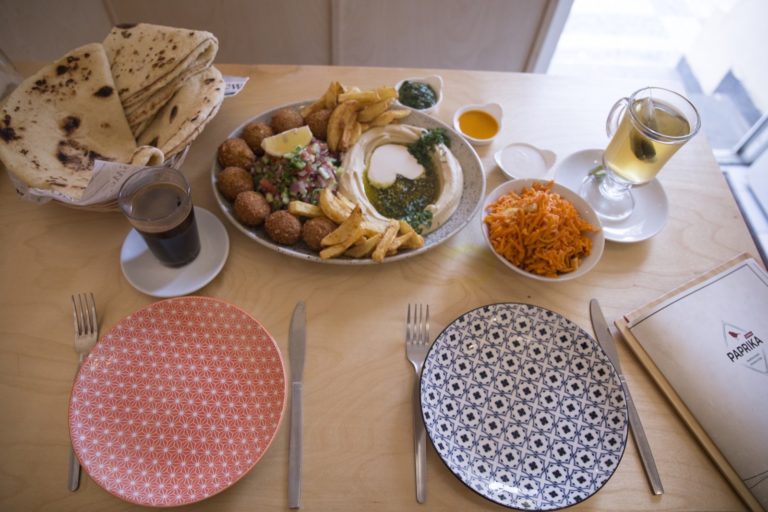
Photo © Alžběta Diringerová
The unsightly and neglected square at the Palmovka metro station is about to change. Prague 8 is preparing several projects to improve this part of Libeň district.
One of the most significant changes will be the sidewalk pavement in the area of the Palmovka intersection, which is being arranged by Prague 8. A notable change will be the removal of elevated concrete surfaces, making the square more open and the whole area clearer. It will be possible to cross it in all directions. There will also be wheelchair accessible modifications.
“The pavement of the area follows the transformation of Palmovka, which we started in the spring of this year. We want to turn the unused space into a high-quality urban place that will be a meeting point and will allow different cultural events or markets, for example,” says Tomáš Hřebík, Prague 8 Councilor of Strategic Development.
The pavement surface will be a mosaic with the same pattern as the new part of Na Žertvách street. The surface in the corners of the intersection will have grass to absorb rainwater and will require benches to sit. A cafe will be built in one of the corners.
It is not possible to plant full-grown trees in the area, as the ceiling of the metro station is just below the intersection. That’s why Prague 8 had UNIT architects designing a unique structure to allow them to hang climbing plants directly on the poles of the Prague Public Transport Company. These plants will add more foliage and will also be dismountable.
“Unsightly green areas will be replaced by modern greenery, which will cool the place and also contribute to the aesthetic aspect of the entire space,” adds Petr Pelc, Prague 8’s representative for the Palmovka area. Traffic signs will also change.
If everything goes well, renovations will take place next year. The project has to be financed by the municipality cooperating with Prague 8.
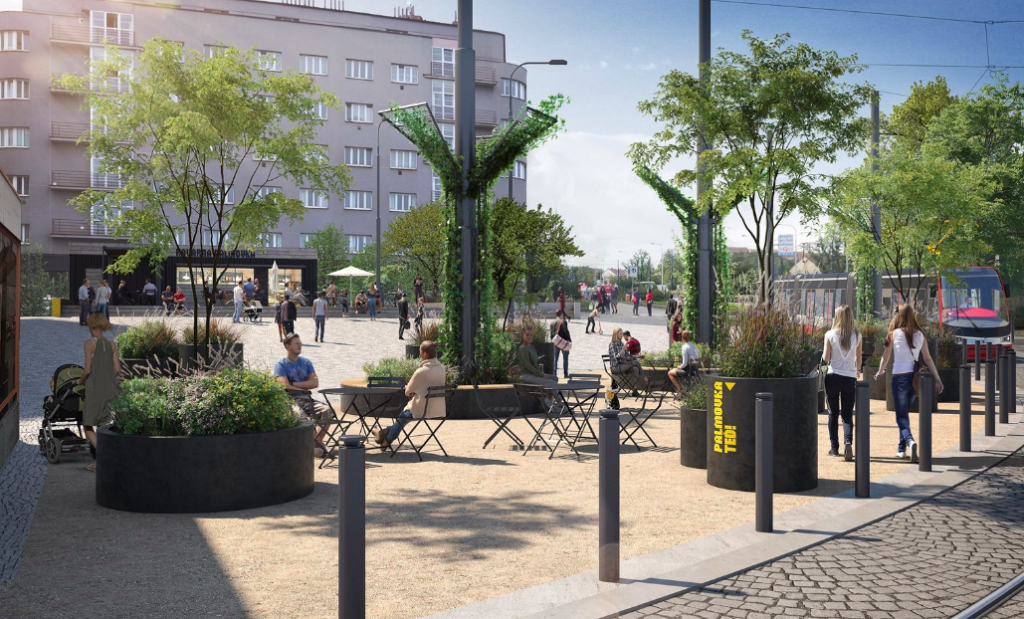
The richest Czech remains the owner of PPF investment group, Petr Kellner, with an estimated property worth 350 billion crowns.
Prime Minister and ANO CEO, Andrej Babiš, fell from second to fourth, his assets decreased by five billion crowns compared to last year. Babiš shifted his position with real estate investor, Radovan Vítek, who increased on 15 billion, bringing him to the second place.
The third is the owner of KKCG, Karel Komárek, who controls Sazka. The ranking was published today on Forbes website. The total assets of entrepreneurs who have worked their way up to the 100th ranking sum 1.2 trillion crowns.
The stakeholder Zdeněk Bakala dropped out of the top ten and was replaced by financier Jiří Šmejc, who is a minority shareholder of Home Credit installment and assets on the Croatian SuperSport. This year’s Forbes rankings have increased by 20 new names. A significant part of them are businessmen who started from scratch and at the beginning of their assets stood modern technology.
Among them Martin Hájek, the chief and owner of Livesport, which provides the fastest sports results worldwide. Forbes estimated his assets at 8.5 billion crowns and ranked him 24th.
Oliver Dlouhý, the founder of Kiwi.com, a ticket search website with assets of CZK 1.5 billion, also entered the ranking for the first time, as well as the founder of the Czech web hosting and CDN service Zdeněk Cendra (CZK 1.8 billion) or founder of the ePojištění.cz, Jan Barta (CZK 1.5 billion).
According to Forbes, Babiš’s equity is predominantly based on the Agrofert holding, and he has been falling in the ranking for the second year due to increasingly poor business results, especially chemical plants producing industrial fertilizers. “Agrofert is in two trust funds, but Andrej Babiš remains a recipient of the benefits resulting from them, which is why we still rank him in the ranking,” Forbes said.
According to Forbes, the richest woman in the Czech Republic is Jitka Cechlová Komárková, who, with a property worth CZK 4.8 billion, took the 50th place. Most of her assets were acquired in the past when dividing the KKCG holding of the Komárek family. The second richest Czech woman is the founder of SIKO, Jaroslava Valová, with three billion and in 75th place, and co-owner of the transport company ICOM, Kateřina Kratochvílová, in the 76th place.
Ranking of the richest Czechs by Forbes magazine (TOP 10):
| Name | Billions of CZK (2018) | Billions of CZK (2019) | |
| 1. | Petr Kellner | 350 | 310 |
| 2. | Radovan Vítek | 75 | 60 |
| 3. | Karel Komárek | 71 | 67 |
| 4. | Andrej Babiš | 70 | 75 |
| 5. | Daniel Křetínský | 66 | 59 |
| 6. | Pavel Baudiš | 38 | 27 |
| 7. | Pavel Tykač | 32 | 31 |
| 8. | Marek Dospiva | 23 | 22 |
| 9. | Eduard Kučera | 22,5 | 19 |
| 10. | Jiří Šmejc | 20 | 17 |
Towards the end of last year, there were references regarding the fact that Tesla was planning to launch its first centre in the Czech Republic and was looking for employees.
A few months later this information was confirmed, and in the first half of this year, the service centre in Prague’s Vysočany officially opened as part of the Advantage Cars complex.
It was the first hint to suggest the opening of an official dealership. Despite the service centre in the Czech Republic, customers still had to travel abroad for their cars. Nevertheless, Elona Muska announced the opening of the first Prague sales point, again in Prague 9 – Vysočany, specifically at Freyova 95/10.
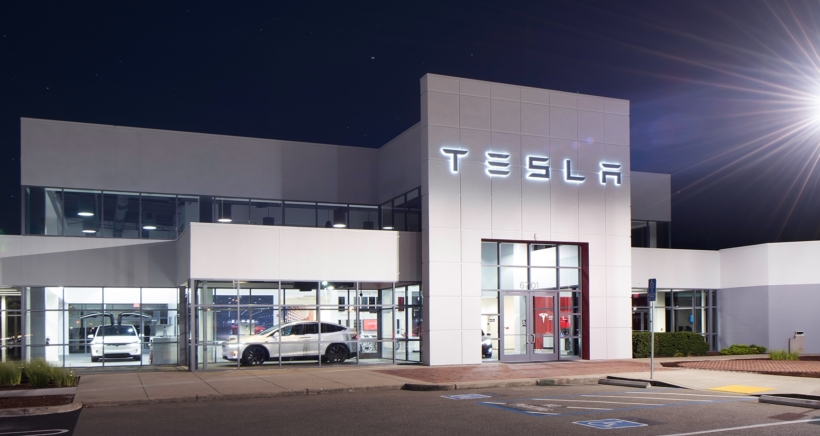
The opening is scheduled to happen in a few days, specifically on October 4th. The same day and the day after there will be test drives and a general presentation of the diverse possibilities for Tesla customers in the Czech Republic. Tesla announced this on its website and in the newsletter they sent to customers.
There will be more expensive cars like Models X and S, as well as the most affordable one, Model 3. At the same time, cars will receive an official Czech price for the first time. The opening of the store was confirmed by an e-mail from the official representation:
We are pleased to invite you to a test drive in our newly opened Tesla store in Prague.
During the meeting, you will have the opportunity to become familiar with the standard safety and comfort features of its Autopilot, learn how to charge Tesla at home or on the go, and see how the electric car can fit without any trouble into your lifestyle.
If you are interested, you can book a test drive with Model S, Model X or Model 3.
Prague residents and visitors can now observe the artworks made by students from three art schools, expressing their view on the 30 years of freedom of Czechoslovakia and the Czech Republic.
The exhibited works originated from a competition organised by the AVU, AMU and UMPRUM schools together with Díky, že můžem (Thanks That We Can Association).
Thanks to this project, dozens of young artists had the opportunity to show their work outside the gallery. “Most of the contemporary art goes to gallery spaces; artistic use of urban furniture is an exception. In addition to the presentation of selected works, the exhibition also raises the question of art in public spaces, which is now in the vast majority provided by commercial communications. Also, where else should freedom be celebrated other than in the streets,” explains Oskar Rejchrt, a member of the Díky, že můžem, which is preparing this year’s sixth annual celebration on November 17th at Národní třída, named Korzo Národní.
The extraordinary presentation is emphasised by augmented reality, right in the viewers’ mobile phones and after downloading Synetech’s Freedom Festival app.
Forty students from different schools and faculties entered the competition called 30 Years of Freedom in Art. The designs, therefore, included graphics and photographs, abstractions and works of a specific nature. The feelings that the works evoke are also diverse – some underline the reasons for the celebrations, others evaluate the thirty years since the fall of the communist regime rather critically.
“I am glad that we are living at a time where we can express ourselves openly, and I know how important it is to draw attention to this constantly. The renowned student competition across three Prague art colleges is a common gesture and a way of commemorating the anniversary and legacy of the revolutionary year 1989 in the form of artistic concepts situated in public spaces,” adds Doc. MgA. Tomáš Vaněk, rector of the Academy of Fine Arts, that this year celebrates 220 years since its foundation.
The winning student work of Dana Vojtíška, Sofia Makanová, Lucie Michnová, Kateřina Kuchtová, Dana Kinská, Jakub Ra, Jana Kvíza, Martina Kyjovská and Jana Hladíká will be displayed on advertising spaces at one of the most frequented streets of Prague, Na Příkopě, and Václav Havel Airport from September 15th to October 15th.
WHEN: 15. 9. – 15. 10. 2019
WHERE: Na Příkopě street and Václav Havel Airport
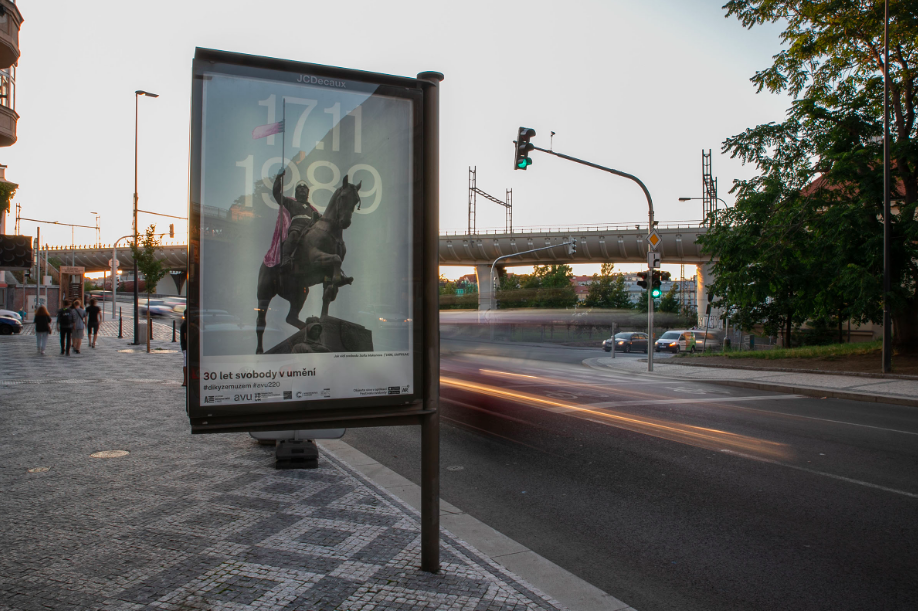
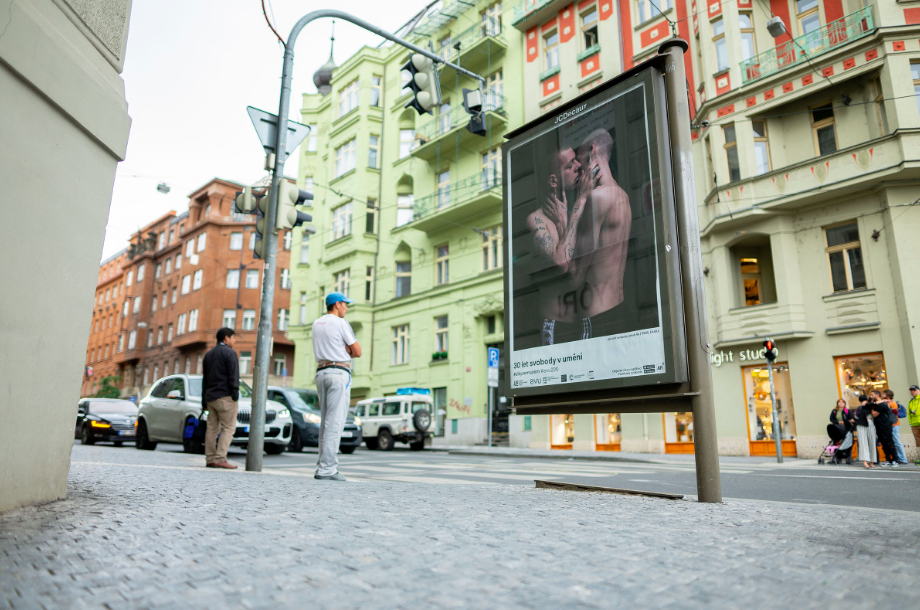
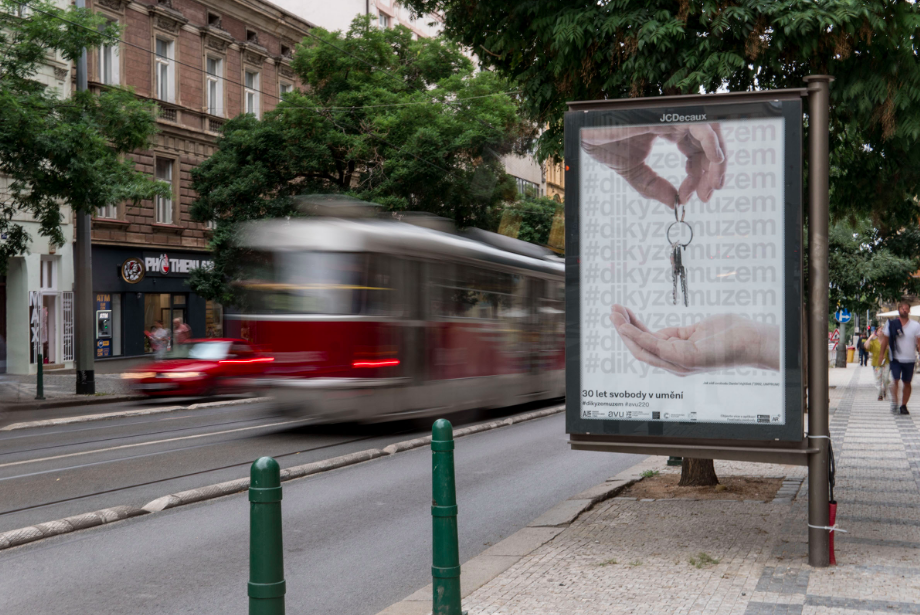
Passengers in Prague’s metro can now use the LTE mobile network on line C from Roztyly to Nádraží Holešovice. Until now, the signal only reached the Museum station. The section between Bořislavka and Motol Hospital on line A is also covered. In total, 16 signal LTE services in the metro station and adjacent tunnels still need to be covered at the end of 2021.
In the upcoming weeks, operators will continue to fine-tune the technology in the newly covered section. Customers can, therefore, use the latest generation mobile services in the Bořislavka – Motol Hospital (4 stations) on line A, in the Museum – Roztyly (8 stations) on line C and from today also in the Muzeum – Nádraží Holešovice on line C (4 stations).
By the end of March 2020, the 4G signal will also be available for passengers in sixteen stations at the centre of Prague: six stations on line A between the Muzeum and Dejvická and ten on line B between the Smíchov train station and Palmovka. Passengers will be able to use the high-speed LTE network in a total of 32 metro stations and adjacent tunnels in spring, which is more than half of the entire extent of Prague metro.
Also, 29 stations and adjacent tunnels will be equipped with state-of-the-art facilities to cover the LTE networks throughout the entire metro area. The original plan predicts the coverage of the 4G signal in all sections by the end of 2022 at the latest. If work continues on the same path as before, passengers will be able to use the signal in all sections of the subway at the end of 2021. “We live online, and the signal in the Prague metro was supposed to be ordinary for a long time. Unfortunately, Prague fell asleep in this field for several years,” said Petr Witowski, General Manager of Prague Transport Company (DPP).
The upcoming new line D could also be covered from the beginning. “The consortium of operators has successfully tested the service on routes A, B, and C, and we are ready to use the experience we’ve achieved in covering line D. We would like to get involved to make the construction really useful,” said Lubor Žatko from T-Mobile and Slovak Telekom on behalf of the Consortium of Operators.
Last April, DPP (Prague Transport Company) approved a contract with a consortium of operators for 20 years; during the first ten years, operators will pay CZK 120 million to DPP. Initially, the operators talked about covering the entire existing metro network by the end of 2022. They now count on this date happening one year earlier.
Although restaurants pay a lot of money to take over public spaces, for many, the expansion of the business area with front gardens is an essential part of their business.
What bothers them the most is that they are not sure if they will get the necessary permission, even if they fit all the requirements. The 1st Deputy Mayor of Prague 1, Petr Hejma, will promote the change.
According to the Prague 1 Chamber of Commerce, the current position of self-government and state administration is not enough transparent and equal to all entrepreneurs. “There will be a sanction if someone does not follow the rules. However, if they adhere to them, they deserve respect and a stable business environment without surprises and difficult or unexplained decisions”, said the chairman of the Chamber, Vladimír Krištof.
The Deputy Mayor of Prague 1, Petr Hejma, also acknowledged this. “The front gardens must satisfy the aesthetic requirements of the historical centre; they must not disturb and restrict their surroundings or prevent passage and are obliged to follow the opening hours strictly. If they adhere to this along with other regulations, I do not see a significant reason why entrepreneurs who operate their front yards properly and without major problems should not have a license for the next season”, said Hejma.
According to the Chamber of Commerce, the behaviour of officials and politicians so far does not correspond to the enormous financial contribution of the restaurant front gardens to the municipal revenues. “They are a major source of income for both Prague 1 and the capital. In 2018 it was roughly 150 million crowns”, emphasised Vladimír Krištof, giving an example in which, an entrepreneur asks for permission for a similar front yard that was allowed a few hundred meters away, but without an explanation, he will not receive it.
The price for placing the front yard in a public space in Prague is high; for example, compared to Vienna, up to ten times. In Prague, you pay for the occupation of the city district between ten and sixty crowns per square meter per day.
Of course, it depends on the attractiveness of the position. You have to pay a similar amount to the Technical Road Administration in Prague.
Therefore, it is not a surprise if the amount paid per month for one front garden exceeds 100 thousand crowns. Prague is one of the most expensive cities in Europe regarding this aspect.
Moreover, according to Krištof, entrepreneurs are charged with a large amount regarding administration.
The Prague 1 Chamber of Commerce has, therefore, started a request that will allow entrepreneurs to apply for a renewal of their front garden electronically every year. “This application is ready, but its implementation in the authorities has been stalling for months”, Krištof criticised.
The Chamber also promotes for entrepreneurs the right to obtain up-to-date information on closures and other events that restrict their premises, the right to reduce the rent for a period of unconstrained restriction or the right to announce any non-renewal of the lease in advance to avoid unnecessary thwarting investment. According to its 1st Deputy Mayor Hejma, the Prague 1 Town Hall is prepared for such a meeting.
“We as self-government must require business people to fulfill their duties, but on the other hand, it is in the interest of our city district and its residents to support them and create quality service. Also, thanks to revenues from the occupation of public space, Prague 1 has enough resources to finance quality education, social services, grant policy, and other services”, declared Hejma.
The first two hundred gas lamps in Prague lit on September 15th, 1847. Their number gradually increased, reaching its peak at the beginning of World War II, when there were about 10,000.
After then there was a decline, and in 1985 the last lamp faded out. Seventeen years ago, Prague decided to return to the romantic gaslighting at the historic centre, and today there are about 700 gas lamps. On Charles Bridge, the gas lamps are lit every year during Advent.
In Prague, the first gas lanterns were inaugurated in the mid-19th century, replacing the oil lamps used before. You could find them in Na Příkopech or Václavském náměstí. In 1940, more than 9,000 gas lamps were illuminating Prague’s streets and squares. Interestingly, they remained in symbiosis with electric lights, which appeared in Prague at the end of the 19th century.
In the second half of the 20th century, lamps were converted from gas to electricity. For the next seventeen years, the magic of gas lamps disappeared from the historic centre.
Was in 2002 when it started their gradual restoration, which has cost over 170 million crowns. First, nine lanterns were installed in Michalské street, Old Town. Gradually, they appeared on the entire Královské cestě. Nowadays, there are seven hundred lamps in the centre.
In Prague, you won’t usually meet a Lampman lighting up the lamps with a long pole. An exception is the time of Advent when you can see this, for example, on the Charles Bridge, being one of the capital attractions regarding pre-Christmas.
Otherwise, they are switched on and off remotely by a signal from the central control room at the same time as the electric lamps.
Because of the glass cover, you can recognize the gas lamp from the electric one. The electric lights have frosted glass, the gas lamps clear glass.
Prague is not the only place where you can see the charm of gas lamps. You can also find them in other capitals such as London, Dublin and Strasbourg. By far the most significant number of gas lamps in operation is in the western part of Berlin, with nearly 40 thousand.
The historic London is also illuminated by gas lamps, especially the area in front of the Buckingham Palace, Clarence House, Green Park and the famous Hyde Park. They also appear in other British cities such as York and Horsham. Furthermore, gas lamps illuminate the historical centre of Zagreb, Croatia, Euro Disney, Strasbourg, France, Krakow and Poland.
After three years of success with the vegetarian and vegan restaurant Etnosvět in Prague’s Vinohrady, a new restaurant has opened in Karlín emphasising healthy food, a stylish environment, and friendly service.
Food connects us is the motto of Spojka Karlín. This new restaurant based in a modern office building, Praga Studios, offers international cuisine that seeks to create new flavours to satisfy vegans, vegetarians, and also meat lovers.
The main idea revolves around Flexitarianism, an increasingly popular plant-based diet that claims to improve your health with an eating regime that’s mostly vegetarian yet still allows an occasional organic meat dish.
Spojka Karlín aims to connect people with food by joining those who want to eat well and at the same time be able to enjoy a meal all in one table, without prejudice. The restaurant transmits its strong philosophy not only on the plate but also with their interior, decorated with dozens of plants that hang and stand.
The restaurant is open at 8 a.m from Monday to Friday and at 9 a.m Saturday and Sunday, offering a breakfast menu with specialities such as sorghum pancakes or porridge with coconut milk and almond butter. You can enjoy breakfast until 11:30 a.m., and at the weekend from 9 a.m. to 2 p.m.
You can also taste an excellent lunch menu between 11:30 a.m. and 4 p.m. and the a la carte menu from 5 p.m. till 10:30 p.m., which adjusts according to the season.
If you have no preference or special diet, you’ll find on the menu a large variety of dishes such as cauliflower gnocchi with forest mushrooms, spinach, and parmesan or a delicious chicken curry with coconut cream, broccoli, purple potatoes, coriander, lemongrass, and lavash.
Health is essential for them, and at the same time, they want the food on the plate to make sense, not using any industrially processed food or refined sugar. The priority is to emphasise quality and overall access to fresh ingredients, always clean and when possible, locally sourced. Vegetables and herbs come from their garden, and meat is organic or from certified free-range suppliers. Fresh homemade pastries and desserts without sugar or gluten are also available.
Make friends with food, at Spojka Karvlín there is freedom of choice.
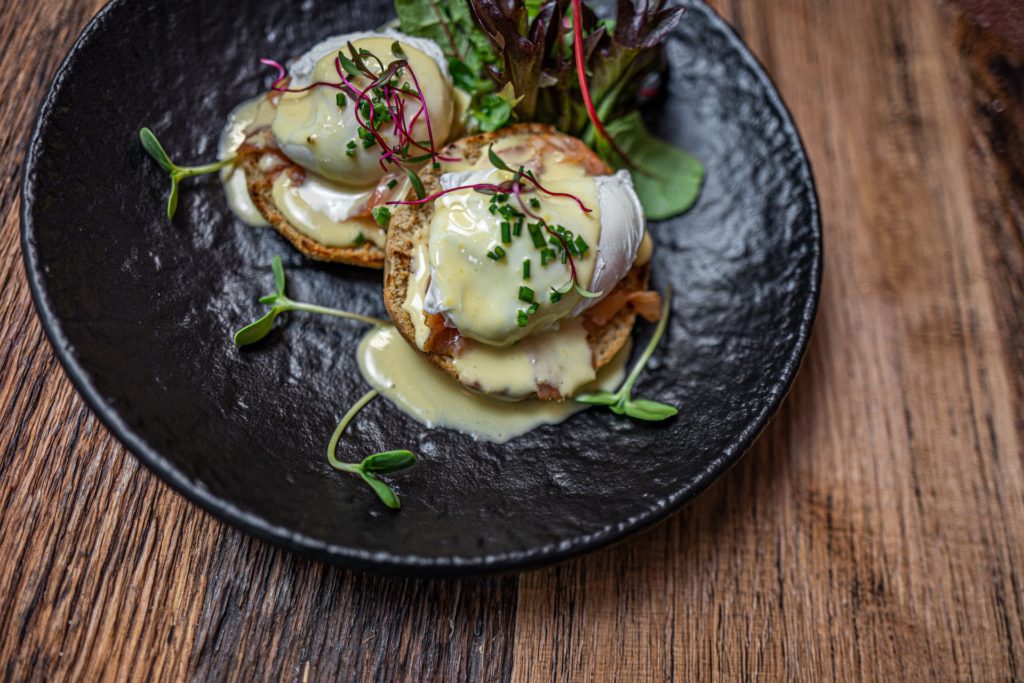
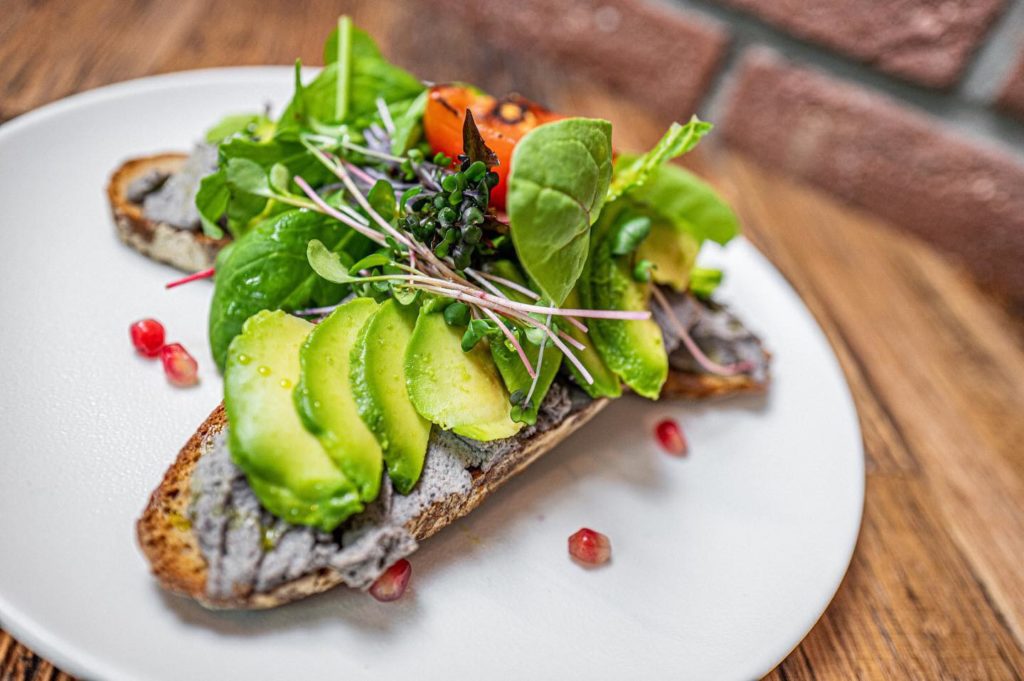
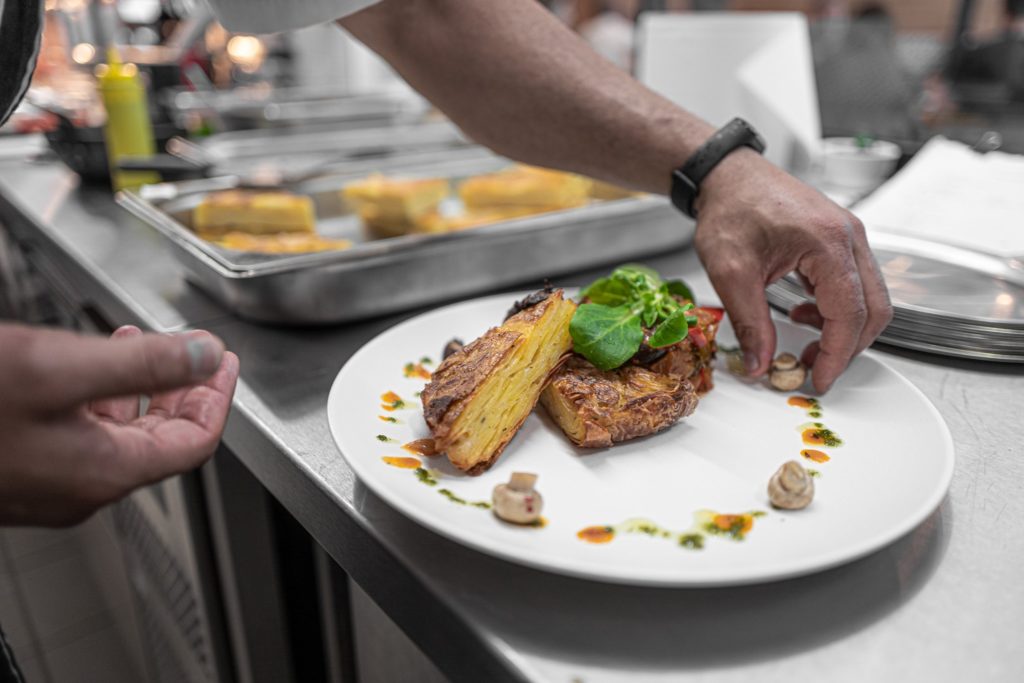
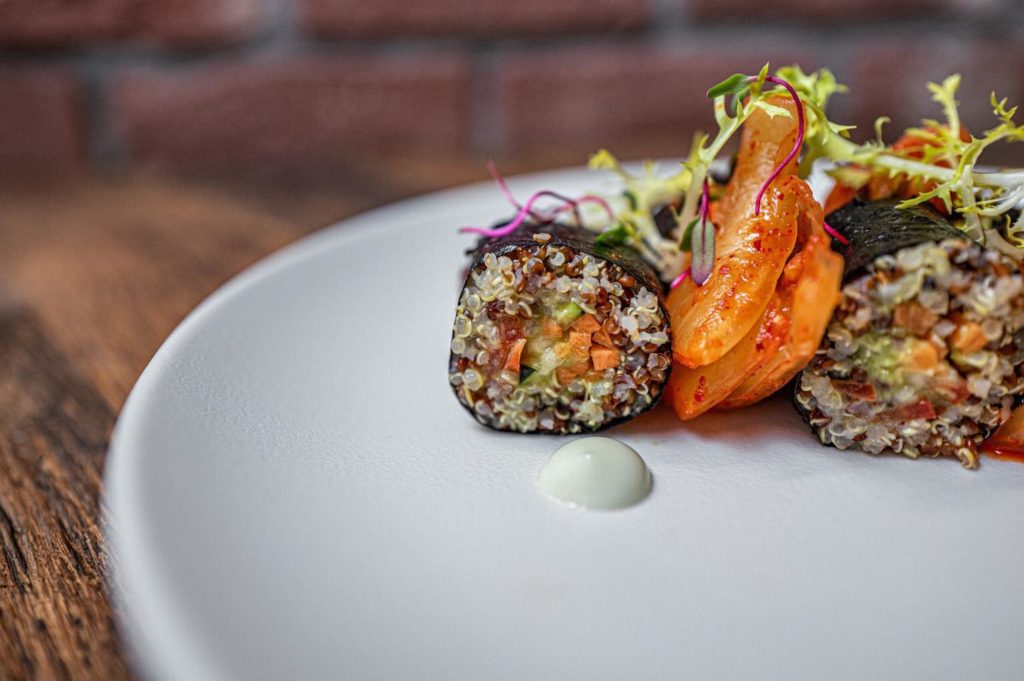
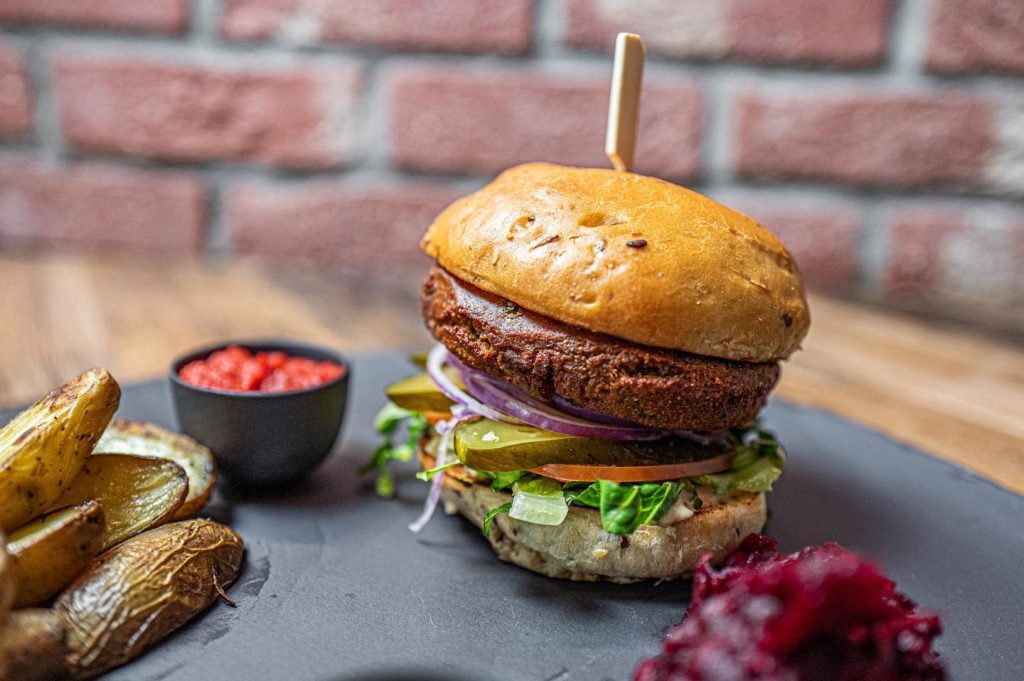
Prague Zoo will celebrate its 88th anniversary. As part of the celebrations, a new pavilion with a unique collection of parrots from all around the world will happen on Saturday 28th September.
The most precious presentation will be the Lear’s macaw, which scientists considered some time ago extinct.
The director of Prague Zoo, Miroslav Bobek, recalls how the idea of a new pavilion with exotic parrots started: “The arrangements for the construction began on the day I met Stanislav Rákos for the first and unfortunately last time. This enthusiastic breeder of exotic birds decided to leave a substantial part of his to Prague Zoo shortly before his death. When we talked about how we could use the money, I mentioned one of our thoughts: to build a brand new pavilion designed especially for parrots in place of cramped aviaries from the early 30s. Mr. Rákos was enthusiastic about this idea to the point where during our meeting, he asked me how much we would need for this purpose”.
Thanks to Stanislav Rákos, Praguers can now look forward to a unique pavilion, which is also appreciated by world-renowned British ornithologist and writer Rosemary Low: “The expositions of the Prague Parrot Pavilion are the most realistic and pleasing I’ve ever seen in any zoo. I am sure that Prague Zoo visitors will be amazed and enchanted!”
Eight habitats and “best” species
“Parrots will be in an environment that corresponds almost perfectly to the areas where they live in the wild. In the pavilion we have eight different habitats occupied by the best species: Lear’s macaw, Pesquet’s parrot, Yellow-billed amazon, Hyacinth macaw and more”, says Bobek.
Several guests will attend the anniversary celebration and the opening of the new pavilion – for instance, the Mayor of Prague Zděnek Hřib, world-famous ballet dancer Jiří Bubeníček or actors Hynek Čermák and Klára Trojanová.
The hopes of paddlers and cyclists to legally have one or two beers have disappeared. MPs have rejected legislation that would have allowed cyclists on minor roads or cycle paths or people canoeing to have a small amount of alcohol in their blood. 89 of the 176 deputies voted to support drinking alcohol, but 101 votes were needed.
Members of the parliament approved the limit of 0.5 per mille for paddlers, but the Senate reestablished the law to add cyclists as well.
“Half a mille, this is no drunkenness”, said Věra Kovářová on Tuesday before the vote on the law. “Zero is nonsense, it’s unrealizable,” said her colleague Petr Pávek.
“We have strict laws, but we know they are not obeyed”, said ODS deputy Marek Benda.
“It’s been seventeen months since we submitted this law”, said Lukáš Bartoň, the author of the proposal to allow paddlers to have alcohol in their blood, just before the election. The result of the vote was disappointing for him.
According to the law, the limit of half per mille should apply to the person who leads.
Senators suggested that the exception of half per mille should also refer to cyclists on a cycle path, a local road or a third-class road. However, the head deputy of ANO, Jaroslav Faltýnek, rejected this. “I will vote to avoid this nonsense”, said Communist member of parliament Zdeněk Ondráček. The ČSSD deputy, Petr Dolínek, also opposed at the debate in the Chamber of Deputies.
The management of Prague 2 will file a complaint against Lime, the company of electric scooters, due to a violation of conditions. They want the Town Hall to cancel the scooter memorandum. Lime rejects the criticism, stating that they do not break the rules. The scooter regulation is also supported by Prague 1.
The dispute between the Town Hall and the company has lasted for several months, and Prague 2 banned their operation on its territory. The Town Hall has been worried about those people that use the scooters, ride along the sidewalk and also leave them at inappropriate places. Based on an agreement, Lime divided the territory of Prague into green and red zones; the red zone blocks the scooters.
“Lime did not submit any of the required documents. Instead, they restricted the red zone in Prague 2 only to náměstí Míru and its immediate surroundings, Folimanka, Vyšehrad, Havlíčkovy, and Hlavní nádraží. It will continue to operate with the ‘borrow and throw’ system without respecting the requirements of the city district” said Deputy Mayor Jan Korseska (ODS).
Last year, the Municipal Police in Prague 2 sanctioned 194 cyclists and scooters; from the beginning of this year to the 15th of September 1048 offenses were committed according to the Town Hall.
At the same time, the City of Prague 2 requests to terminate the memorandum on the Development of Shared Bicycle Services that establishes the red and green zones mentioned. Nevertheless, the repeal would also affect shared transport services such as Rekola, which provides pink bikes.
“We satisfy the requirements that we signed up for in the memorandum. Therefore, the service is available in limited traffic in Prague 2. We believe that we are right when the scooter service in Prague 2 works as it is now set up. We agree with Prague 2 in welcoming the clarification of this situation,” said Ondřej Široký, Operations Manager of Lime.
In addition to Lime and Rekola in Prague, Car4way and Revolt carsharing services also work. Since April, the Homeport company has entered the Prague market.

